Themed collection The Mechanics of Supramolecular Chemistry

The mechanics of supramolecular chemistry
We are delighted to present this collection of articles to celebrate Eric V. Anslyn’s 60th birthday.

Chem. Commun., 2020,56, 6467-6468
https://doi.org/10.1039/D0CC90220A
Activatable molecular agents for cancer theranostics
Activatable molecualr agents that intergrate diagnosis and treatment modalities have attracted great attention due to its abilities of personalized therapy and real-time monitoring of therapeutic outcome.
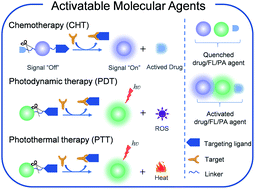
Chem. Sci., 2020,11, 618-630
https://doi.org/10.1039/C9SC05460J
Supramolecular chemistry of carbon nano-onions
An exhaustive and succinct minireview of the various reported approaches to the non-covalent surface modification of carbon nano-onions (CNOs).
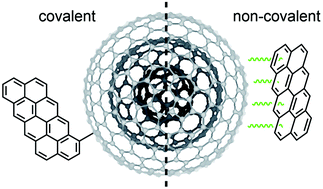
Nanoscale, 2020,12, 9352-9358
https://doi.org/10.1039/D0NR01713B
Shapeshifting molecules: the story so far and the shape of things to come
This review describes the synthesis and application of shapeshifting molecules, whose covalent skeletons dynamically reconfigure in response to their surroundings.
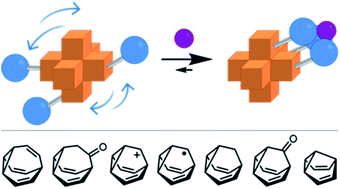
Chem. Sci., 2020,11, 324-332
https://doi.org/10.1039/C9SC05482K
Molecular probe design via the “covalent-assembly” principle
Fluorescent probes are useful molecular tools. We summarize the recent progress with the “covalent-assembly” design principle, which warrants high-performance fluorescence probes exhibiting a highly sensitive turn-on signal from the dark background.

Chem. Commun., 2020,56, 9067-9078
https://doi.org/10.1039/D0CC00542H
Recent developments in the construction and applications of platinum-based metallacycles and metallacages via coordination
We review the recent developments in the growing field of platinum-based, coordination-driven self-assembly, and bringing together the key results.
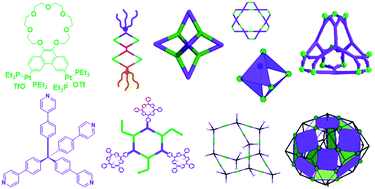
Chem. Soc. Rev., 2020,49, 3889-3919
https://doi.org/10.1039/D0CS00038H
Design and applications of metal-based molecular receptors and probes for inorganic phosphate
We discuss and review the strategies of metal-based receptors targeting phosphate.
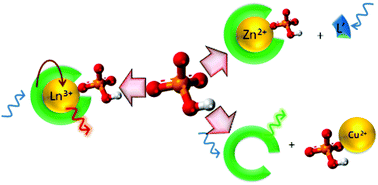
Chem. Soc. Rev., 2020,49, 1090-1108
https://doi.org/10.1039/C9CS00543A
Supramolecular materials based on AIE luminogens (AIEgens): construction and applications
This review presents comprehensive discussions on the recent development in supramolecular materials based on luminogens with aggregation-induced emission (AIE) characteristics.
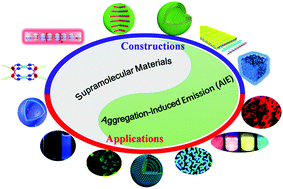
Chem. Soc. Rev., 2020,49, 1144-1172
https://doi.org/10.1039/C9CS00495E
Excited-state intramolecular proton-transfer (ESIPT) based fluorescence sensors and imaging agents
We review recent advances in the design and application of excited-state intramolecular proton-transfer (ESIPT) based fluorescent probes. These sensors and imaging agents (probes) are important in biology, physiology, pharmacology, and environmental science.
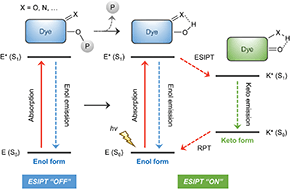
Chem. Soc. Rev., 2018,47, 8842-8880
https://doi.org/10.1039/C8CS00185E
Biomimetic carbohydrate recognition
Binding saccharides with non-covalent interactions is challenging, especially in the natural medium of water, but synthetic carbohydrate receptors can be surprisingly effective.
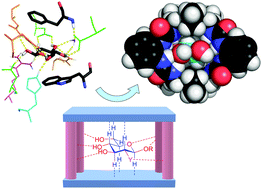
Chem. Soc. Rev., 2020,49, 2531-2545
https://doi.org/10.1039/C9CS00391F
Molecular logic gates: the past, present and future
Molecular logic gates, now with more than two decades of collective exploration, are poised for practical applications.
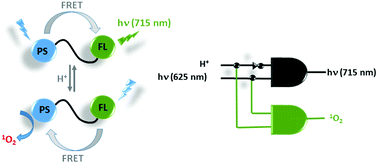
Chem. Soc. Rev., 2018,47, 2228-2248
https://doi.org/10.1039/C7CS00491E
Fluorescent molecular logic gates based on photoinduced electron transfer (PET) driven by a combination of atomic and biomolecular inputs
A meeting point for entities from chemistry, enzymology and computer science.

Chem. Commun., 2020,56, 6838-6841
https://doi.org/10.1039/D0CC00478B
Mixed alkoxy/hydroxy 1,8-naphthalimides: expanded fluorescence colour palette and in vitro bioactivity
An efficient and functional group tolerant route to access hydroxy 1,8-naphthalimides has been used to synthesise a range of mono- and disubstituted hydroxy-1,8-naphthalimides with fluorescence emissions covering the visible spectrum.
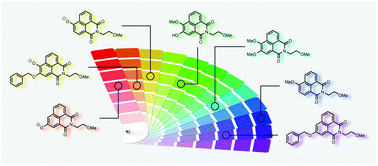
Chem. Commun., 2020,56, 6866-6869
https://doi.org/10.1039/D0CC01251C
An endoplasmic reticulum-targeting fluorescent probe for imaging ˙OH in living cells
A new ER-targeting fluorescent probe for ˙OH is developed and applied to imaging ˙OH generation as well as lipid droplet formation in ER stress.
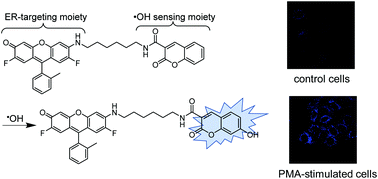
Chem. Commun., 2020,56, 6344-6347
https://doi.org/10.1039/D0CC00233J
Supramolecular fluorogenic peptide sensor array based on graphene oxide for the differential sensing of ebola virus
Principal component analysis of a fluorescent supramolecular sensor array based on graphene oxide can be used to differentiate ebola virus from marburg virus and receptor-extensive vesicular stomatitis virus.
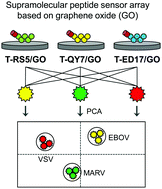
Chem. Commun., 2020,56, 5735-5738
https://doi.org/10.1039/C9CC09981F
One-pot synthesis of β-cyclodextrin modified Au nanoclusters with near-infrared emission
β-Cyclodextrin modified gold nanoclusters with near-infrared emission were facilely and successfully prepared based on a one-pot and green supramolecular macrocycle modification strategy.
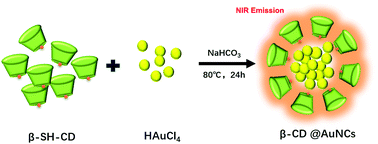
Chem. Commun., 2020,56, 5580-5583
https://doi.org/10.1039/D0CC00713G
Visualization of penicillin G acylase in bacteria and high-throughput screening of natural inhibitors using a ratiometric fluorescent probe
A ratiometric fluorescent probe (PNA) has been developed to sense and image bacterial penicillin G acylase in addition to the high-throughput screening of PGA inhibitors.

Chem. Commun., 2020,56, 4640-4643
https://doi.org/10.1039/D0CC00197J
Visualization of carboxylesterase 2 with a near-infrared two-photon fluorescent probe and potential evaluation of its anticancer drug effects in an orthotopic colon carcinoma mice model
We have established a near-infrared two-photon fluorescent probe for the detection of CE2 with high selectivity and sensitivity.
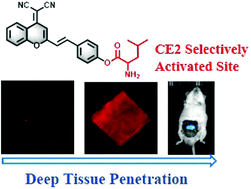
Chem. Commun., 2020,56, 4412-4415
https://doi.org/10.1039/D0CC00297F
Using changes in speciation in a dynamic combinatorial library as a fingerprint to differentiate the methylation states of arginine
A dynamic combinatorial library was shown to provide a direct method of sensing methylated arginine and lysine due to differences in speciation. This provides the first sensor array for all the methylation states of arginine.
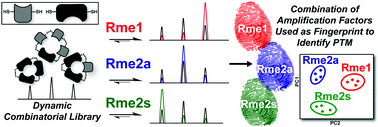
Chem. Commun., 2020,56, 3947-3950
https://doi.org/10.1039/D0CC00415D
Chemical signal cascading in a supramolecular network
Stimuli-responsive chemical communication is enabled in a self-sorted system of cucurbituril host–guest complexes.

Chem. Commun., 2020,56, 3737-3740
https://doi.org/10.1039/D0CC00217H
Radio- and nano-chemistry of aqueous Ga(III) ions anchored onto graphene oxide-modified complexes
The non-covalent radiolabelling of new graphene oxide-bis(thiosemicarbazonato) nanohybrids with gallium-68 and zirconium-89 ions is reported herein for the first time.
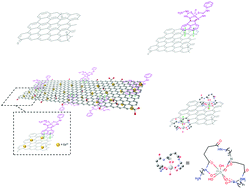
Nanoscale, 2020,12, 6603-6608
https://doi.org/10.1039/C9NR10145D
Bio-inspired assembly in a phospholipid bilayer: effective regulation of electrostatic and hydrophobic interactions for plasma membrane specific probes
A simple assembly system of phospholipid bilayer and probes via electrostatic and hydrophobic interactions was constructed.
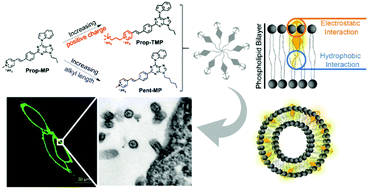
Chem. Commun., 2020,56, 3661-3664
https://doi.org/10.1039/D0CC00679C
Template-guided selection of RNA ligands using imine-based dynamic combinatorial chemistry
This study establishes the applicability of imine-based dynamic combinatorial chemistry to discover non-covalent ligands for RNA targets.
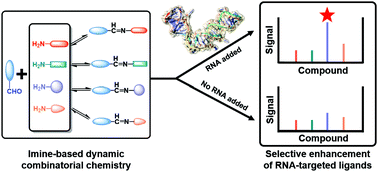
Chem. Commun., 2020,56, 3555-3558
https://doi.org/10.1039/D0CC00266F
Aggregation induced emission (AIE) active 4-amino-1,8-naphthalimide-Tröger's base for the selective sensing of chemical explosives in competitive aqueous media
The 4-amino-1,8-naphthalimide Tröger's base based AIE-active supramolecular scaffold was synthesized and employed as a highly selective and sensitive fluorescent sensor for nitroaromatic explosives sensing in competitive aqueous media.

Chem. Commun., 2020,56, 2562-2565
https://doi.org/10.1039/C9CC08457F
A fluorescent naphthalimide NADH mimic for continuous and reversible sensing of cellular redox state
A new naphthalimide based NADH mimic that functions as a fully reversible fluorescent “on off” probe for redox state has been synthesised and evaluated.
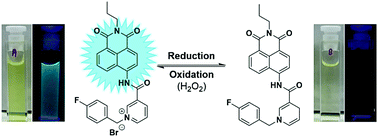
Chem. Commun., 2020,56, 2240-2243
https://doi.org/10.1039/C9CC09748A
Crown ether-appended calix[2]triazolium[2]arene as a macrocyclic receptor for the recognition of the H2PO4− anion
We report the synthesis of a crown ether-appended calix[2]triazolium[2]arene receptor that shows excellent selectivity for H2PO4− and the binding ability and mode of the receptor to H2PO4− were demonstrated by 1H NMR studies and DFT calculation.
![Graphical abstract: Crown ether-appended calix[2]triazolium[2]arene as a macrocyclic receptor for the recognition of the H2PO4− anion](/en/Image/Get?imageInfo.ImageType=GA&imageInfo.ImageIdentifier.ManuscriptID=C9CC08906C&imageInfo.ImageIdentifier.Year=2020)
Chem. Commun., 2020,56, 1038-1041
https://doi.org/10.1039/C9CC08906C
A 2,3-dialkoxynaphthalene-based naphthocage
A 2,3-dialkoxynaphthalene-based naphthocage was synthesized. It shows similarly strong binding affinity to organic cations as the 2,6-dialkoxynaphthalene-based naphthocage but different guest preference and conformational response.
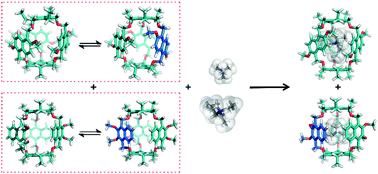
Chem. Commun., 2020,56, 888-891
https://doi.org/10.1039/C9CC09585C
A fluorogenic probe for tracking GSH flux in developing neurons
We have developed an ultrasensitive assay for GSH in order to help uncover its role in neuronal development.
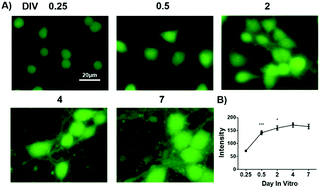
Chem. Commun., 2020,56, 515-518
https://doi.org/10.1039/C9CC07753G
Reaction-based indicator displacement assay (RIA) for the development of a triggered release system capable of biofilm inhibition
Here, a reaction-based indicator displacement hydrogel assay (RIA) was developed for the detection of hydrogen peroxide (H2O2) via the oxidative release of the optical reporter Alizarin Red S (ARS).
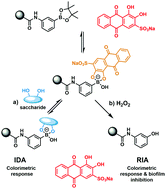
Chem. Commun., 2019,55, 15129-15132
https://doi.org/10.1039/C9CC07759F
Nanomolar detection of adenosine triphosphate (ATP) using a nanostructured fluorescent chemosensing ensemble
A simple nanostructured chemosensing ensemble for fluorescent turn-on sensing of ATP in aqueous solutions and inside living cells using the indicator displacement assay (IDA) method results in a very low detection limit of 6.8 nM.
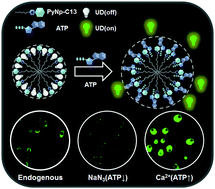
Chem. Commun., 2019,55, 14135-14138
https://doi.org/10.1039/C9CC08054F
Fluorescence imaging of a potential diagnostic biomarker for breast cancer cells using a peptide-functionalized fluorogenic 2D material
A fluorogenic 2D material has been developed for the imaging of PROCR, a potential biomarker for triple-negative breast cancer.
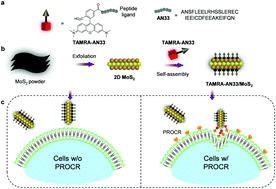
Chem. Commun., 2019,55, 13235-13238
https://doi.org/10.1039/C9CC06399D
Supramolecular chirality of coordination polymers of Ag+ with a chiral thiol ligand that bears a β-turn structure
The coordination polymers of Ag+ with a β-turn containing chiral thiol ligand exhibit supramolecular chirality showing simultaneously the majority rules effect (MRE) and racemate rules effect (RRE).
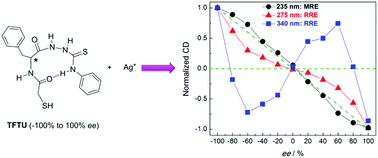
Chem. Commun., 2019,55, 12849-12852
https://doi.org/10.1039/C9CC07590A
Receptors for sulfate that function across a wide pH range in mixed aqueous–DMSO media
Water soluble macrocyclic squaramides bind selectively to sulfate in aqueous–DMSO mixtures across a pH range from 3.2–14.
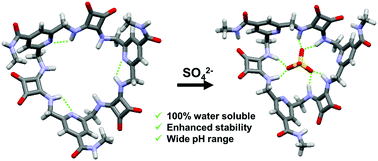
Chem. Commun., 2019,55, 12312-12315
https://doi.org/10.1039/C9CC06812K
In vivo ratiometric tracking of endogenous β-galactosidase activity using an activatable near-infrared fluorescent probe
Herein, we exemplify BODIPY-βgal as a ratiometric light-up NIR probe for the quantitative sensing of endogenous β-gal distribution in living cells, and real-time tracking of β-gal activity in tumor-bearing nude mice.

Chem. Commun., 2019,55, 12308-12311
https://doi.org/10.1039/C9CC06869D
“Turn-on” fluorescence sensing of volatile organic compounds using a 4-amino-1,8-naphthalimide Tröger's base functionalised triazine organic polymer
The 4-amino-1,8-naphthalimide Tröger's base functionalized triazine covalent organic polymer was synthesised and employed as a “turn-on” fluorescent sensor for the discriminative sensing of volatile organic compounds (VOCs).
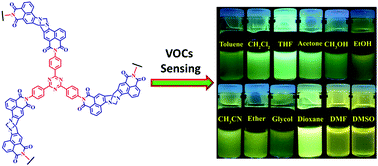
Chem. Commun., 2019,55, 12140-12143
https://doi.org/10.1039/C9CC05585A
A water-soluble dual-site fluorescent probe for the rapid detection of cysteine with high sensitivity and specificity
A water-soluble turn-on fluorescent probe has been developed for the rapid, sensitive and specific detection of Cys.
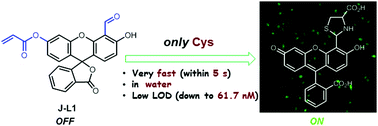
Chem. Commun., 2019,55, 11762-11765
https://doi.org/10.1039/C9CC06468K
Ratiometric two-photon fluorescent probe for in situ imaging of carboxylesterase (CE)-mediated mitochondrial acidification during medication
A probe for imaging of mitochondrial carboxylesterase and pH has been developed for the visualization of carboxylesterase-mediated acidification in hepatoma cells and hepatic tissues during the administration of antipyretic and anti-inflammatory drugs.

Chem. Commun., 2019,55, 11358-11361
https://doi.org/10.1039/C9CC05759E
Visualizing biofilm by targeting eDNA with long wavelength probe CDr15
We developed a small molecule CDr15, which has eDNA selectivity of bacterial biofilm.
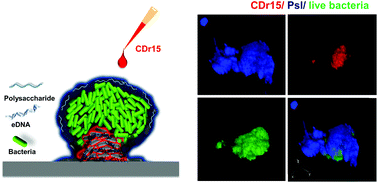
Biomater. Sci., 2019,7, 3594-3598
https://doi.org/10.1039/C9BM00152B
A colorimetric and fluorescent lighting-up sensor based on ICT coupled with PET for rapid, specific and sensitive detection of nitrite in food
A colorimetric and fluorogenic sensor exhibiting rapid, specific and sensitive detection of potentially toxic nitrite in food is described.
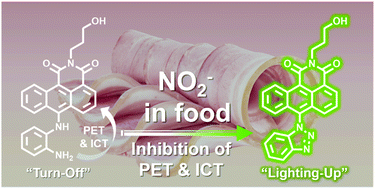
Chem. Commun., 2019,55, 9947-9950
https://doi.org/10.1039/C9CC05048E
A reversibly mechanochromic conjugated polymer
A reversibly mechanochromic conjugated polymer, based on the thermal polymerization of a diphenyldisulfide-containing bisdiacetylene, was developed.
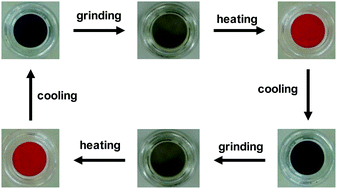
Chem. Commun., 2019,55, 9395-9398
https://doi.org/10.1039/C9CC03951A
Adjustable chiral self-sorting and self-discriminating behaviour between diamond-like Tröger's base-linked cryptands
Adjustable chiral self-sorting and self-discriminating behaviour between diamond-like Tröger's base-linked cryptands was reported, which could be regulated by external stimuli easily.

Chem. Commun., 2019,55, 8072-8075
https://doi.org/10.1039/C9CC03577J
Shape-persistent pyrrole-based covalent organic cages: synthesis, structure and selective gas adsorption properties
Pyrrole based organic cages for selective CO2 capture.
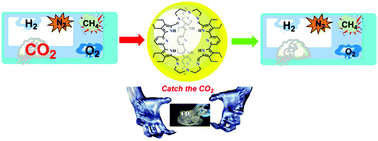
Chem. Commun., 2019,55, 6185-6188
https://doi.org/10.1039/C9CC02490E
A far-red fluorescent probe for sensing laccase in fungi and its application in developing an effective biocatalyst for the biosynthesis of antituberculous dicoumarin
A far-red fluorescent probe for sensing laccase in fungi and its application in developing an effective biocatalyst for the biosynthesis of antituberculous dicoumarin.
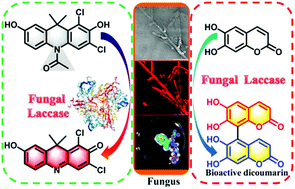
Chem. Commun., 2019,55, 3951-3954
https://doi.org/10.1039/C9CC01579E
Ratiometric fluorescent probe for sensing Streptococcus mutans glucosyltransferase, a key factor in the formation of dental caries
A naphthalimide-based ratiometric fluorescent probe was designed for sensing (and inhibitor screening) of pathogenic bacterial glucosyltransferases associated with the formation of dental caries.
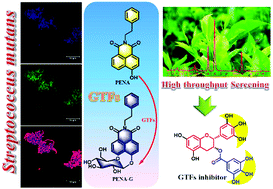
Chem. Commun., 2019,55, 3548-3551
https://doi.org/10.1039/C9CC00440H
NAG-targeting fluorescence based probe for precision diagnosis of kidney injury
NAG-targeting fluorescent probe for sensing proximal tubule cells in patient's crude urine and precision diagnosis for kidney injury unit.
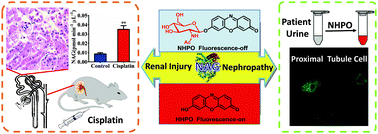
Chem. Commun., 2019,55, 1955-1958
https://doi.org/10.1039/C8CC10311A
A naphthoimidazolium-cholesterol derivative as a ratiometric fluorescence based chemosensor for the chiral recognition of carboxylates
We report a naphthoimidazolium-cholesterol derivative (NI-chol 1) as a fluorescence based chemosensor for chiral recognition via imidazolium (C–H)+–anion binding.
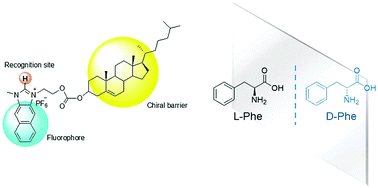
Chem. Commun., 2018,54, 13264-13267
https://doi.org/10.1039/C8CC06262E
ESIPT-based fluorescence probe for the rapid detection of peroxynitrite ‘AND’ biological thiols
An ESIPT-based ‘AND’ logic fluorescence probe (GSH-ABAH) was developed for the simultaneous detection of ONOO− ‘AND’ biological thiols.
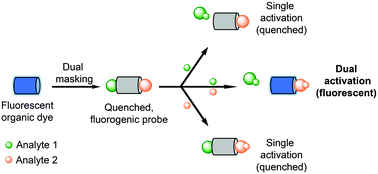
Chem. Commun., 2018,54, 11336-11339
https://doi.org/10.1039/C8CC06917D
ESIPT-based ratiometric fluorescence probe for the intracellular imaging of peroxynitrite
In this work, we set out to develop an ER directed ESIPT-based ONOO− ratiometric fluorescent probe (ABAH-LW).
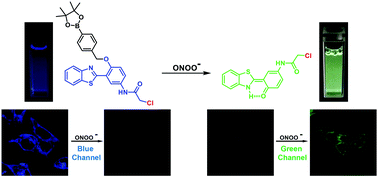
Chem. Commun., 2018,54, 9953-9956
https://doi.org/10.1039/C8CC04919J
ESIPT-based fluorescence probe for the rapid detection of hypochlorite (HOCl/ClO−)
ESIPT-based fluorescence probes are emerging as an attractive tool for the detection of biologically relevant analytes owing to their unique photophysical properties.
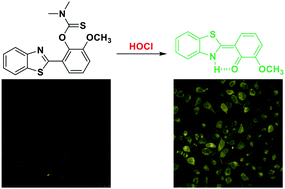
Chem. Commun., 2018,54, 8522-8525
https://doi.org/10.1039/C8CC03717E
‘AND’-based fluorescence scaffold for the detection of ROS/RNS and a second analyte
A novel fluorescence-based scaffold was developed enabling the production of ‘AND’ based fluorescence probes – ROS/RNS and a second analyte.

Chem. Commun., 2018,54, 8466-8469
https://doi.org/10.1039/C8CC04316G
A hemicyanine based ratiometric fluorescence probe for mapping lysosomal pH during heat stroke in living cells
Heat stroke is a lethal condition which can cause dysfunction in the central nervous system, multi-organ damage and even death.
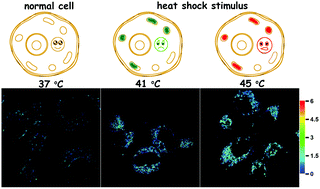
Chem. Commun., 2018,54, 5518-5521
https://doi.org/10.1039/C8CC02330A
Long-wavelength TCF-based fluorescence probes for the detection and intracellular imaging of biological thiols
Two ‘turn on’ TCF-based fluorescence probes were developed for the detection of biological thiols (TCF-GSH and TCFCl-GSH).
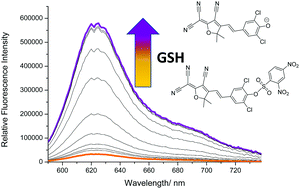
Chem. Commun., 2018,54, 4786-4789
https://doi.org/10.1039/C8CC01661E
Supramolecular glyco-poly-cyclodextrin functionalized thin-layer manganese dioxide for targeted stimulus-responsive bioimaging
A fluorogenic 2D glycoprobe based on poly-cyclodextrin and thin-layer manganese dioxide has been developed for the targeted and stimulus-responsive imaging of cancer cells.
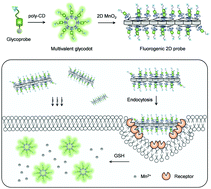
Chem. Commun., 2018,54, 4037-4040
https://doi.org/10.1039/C8CC00920A
A fluorescent peptidyl substrate for visualizing peptidyl-prolyl cis/trans isomerase activity in live cells
Imaging active PPIases in live cells with a small molecular probe.
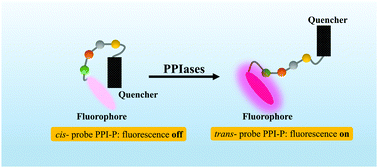
Chem. Commun., 2018,54, 1857-1860
https://doi.org/10.1039/C7CC09135D
Fluorescence detection and removal of copper from water using a biobased and biodegradable 2D soft material
We have developed a green and robust fluorogenic (λex = 410 nm, λem = 510 nm) cellulose membrane using graphene oxide (GO) as a construct for simultaneous copper ion recognition and filtration at environmentally relevant levels.
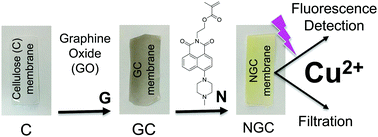
Chem. Commun., 2018,54, 184-187
https://doi.org/10.1039/C7CC08035B
ESIPT-based fluorescence probe for the ratiometric detection of superoxide
A simple ESIPT-based fluorescence probe (HMBT-LW) was developed for the detection of superoxide (O2˙−).

New J. Chem., 2019,43, 2875-2877
https://doi.org/10.1039/C8NJ05656K
Accurate chiral pattern recognition for amines from just a single chemosensor
The current work proposes a novel method for accurate pattern recognition of (mono- and di-) amines and determination of enantiomeric excess (ee) using molecular self-assembly.
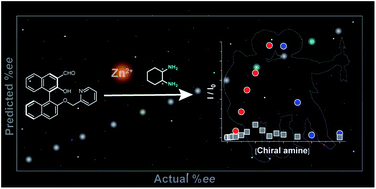
Chem. Sci., 2020,11, 3790-3796
https://doi.org/10.1039/D0SC00194E
Proximal charge effects on guest binding to a non-polar pocket
Science still does not have the ability to accurately predict changes in ligand affinity induced by proximal charged groups.
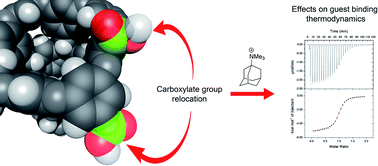
Chem. Sci., 2020,11, 3656-3663
https://doi.org/10.1039/C9SC06268H
Tuning the anion binding properties of lanthanide receptors to discriminate nucleoside phosphates in a sensing array
Discrimination of nucleoside phosphate anions in the first supramolecular sensing array using luminescent lanthanide complexes.
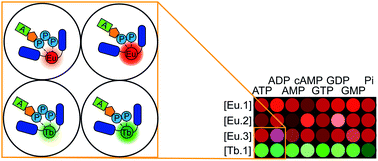
Chem. Sci., 2020,11, 3619-3628
https://doi.org/10.1039/D0SC00343C
Photoactive preorganized subphthalocyanine-based molecular tweezers for selective complexation of fullerenes
A tweezer-like subphthalocyanine-based ensemble has been developed for the selective recognition of fullerenes. The physicochemical properties of both the photoactive receptor and its inclusion complexes with fullerenes have been investigated.
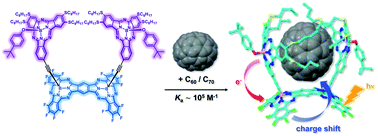
Chem. Sci., 2020,11, 3448-3459
https://doi.org/10.1039/D0SC00059K
Independent control over size, valence, and elemental composition in the synthesis of DNA–nanoparticle conjugates
DNA–nanoparticle conjugates can be synthesized with independent control over size, valence and elemental composition using a template-based strategy.
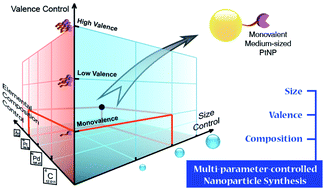
Chem. Sci., 2020,11, 1564-1572
https://doi.org/10.1039/C9SC05656D
Protein encapsulation: a new approach for improving the capability of small-molecule fluorogenic probes
Herein, we report a protein-based hybridization strategy that exploits the host–guest chemistry of HSA (human serum albumin) to solubilize the otherwise cell impermeable ONOO− fluorescent probe Pinkment-OAc.
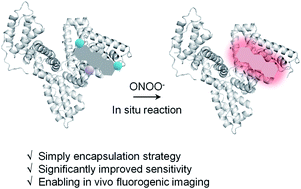
Chem. Sci., 2020,11, 1107-1113
https://doi.org/10.1039/C9SC03961A
Endoplasmic reticulum targeting fluorescent probes to image mobile Zn2+
Two endoplasmic reticulum (ER) targeting probes were developed to image mobile Zn2+ to help understand Zn2+ related biological processes in the ER.
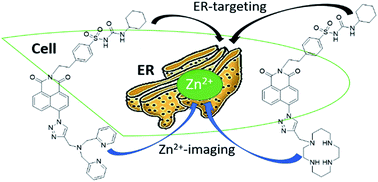
Chem. Sci., 2019,10, 10881-10887
https://doi.org/10.1039/C9SC04300D
Rational design of a multifunctional molecular dye for dual-modal NIR-II/photoacoustic imaging and photothermal therapy
Theranostic nanoprobes (SYL NPs) prepared from a newly designed NIR-II fluorophore and FDA approved DSPE-mPEG5000 were well tolerated and exhibited multifunctional potential in diagnosis (photoacoustic & fluorescence imaging) and phototherapy in animal models.
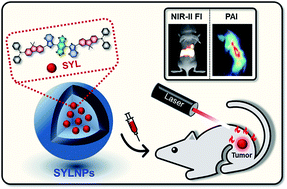
Chem. Sci., 2019,10, 8348-8353
https://doi.org/10.1039/C9SC03504D
RGD conjugated cell uptake off to on responsive NIR-AZA fluorophores: applications toward intraoperative fluorescence guided surgery
The tumour switches on the NIR-AZA emission for fluorescence guided surgery.
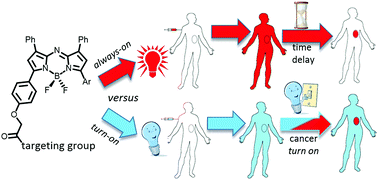
Chem. Sci., 2019,10, 6944-6956
https://doi.org/10.1039/C9SC02197C
Evaluation of HOCl-generating anticancer agents by an ultrasensitive dual-mode fluorescent probe
Probe C7 for the first time presents different modes of fluorescence signals to both nanomolar and micromolar concentrations of HOCl.
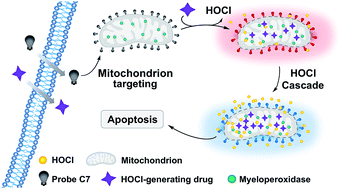
Chem. Sci., 2019,10, 3715-3722
https://doi.org/10.1039/C9SC00180H
The development of a novel AND logic based fluorescence probe for the detection of peroxynitrite and GSH
We have developed a novel AND logic based fluorescence probe for the simultaneous detection of ONOO− and GSH (GSH-PF3).
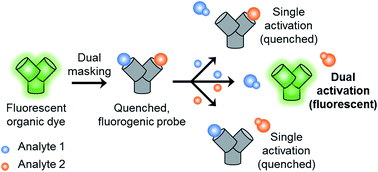
Chem. Sci., 2018,9, 3672-3676
https://doi.org/10.1039/C8SC00733K
Enhanced ion binding by the benzocrown receptor and a carbonyl of the aminonaphthalimide fluorophore in water-soluble logic gates
Fluorescent logic gates with benzocrown ethers attached at the imide naphthalimide exhibit synergistic binding of Na+ and K+ in aqueous methanol and water.
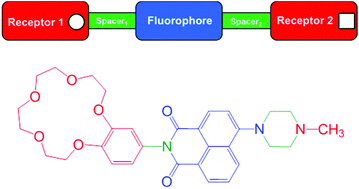
Org. Biomol. Chem., 2020,18, 4773-4782
https://doi.org/10.1039/D0OB00059K
Classical and non-classical melatonin receptor agonist-directed micellization of bipyridinium-based supramolecular amphiphiles in water
A series of melatonin receptor agonists prove capable of templating soft matter assemblies with concomitant enhancement of the material's surface active properties in water.
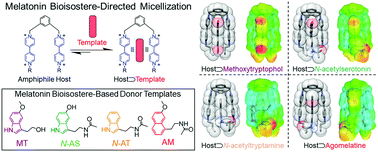
Soft Matter, 2020,16, 4788-4799
https://doi.org/10.1039/D0SM00424C
Disposable paper strips for carboxylate discrimination
A fluorescent macromolecular chemosensor, built from readily available components, performs chemical fingerprinting of carboxylate anions on low-cost, disposable paper supports.
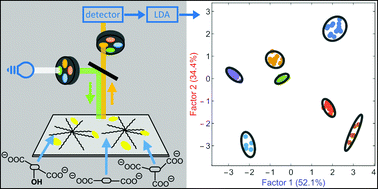
Analyst, 2020,145, 3505-3516
https://doi.org/10.1039/D0AN00137F
About this collection
The Mechanics of Supramolecular chemistry refers to the underlying “physical organic chemistry” of the field. This collection of works, Guest Edited by Professor Tony James, Professor Jonathan Sessler and Professor Bruce Gibb, was conceived to celebrate the 60th Birthday of Eric V Anslyn who has been an inspiration to countless minds working on solving the fundamental science behind supramolecular chemistry.
”My childhood was filled with repairing and constructing mechanical entities, such as internal combustion motors, where many components work together to achieve a function. Analogously, the field of supramolecular chemistry creates systems of high complexity that achieve functions or perform tasks. Therefore, in retrospect a career in supramolecular chemistry appears to be simply an extension of childhood hobbies”
Eric V Anslyn - Beilstein J Org Chem. 2016; 12: 362–376.
Articles in this themed collection will be added below as soon as possible after they are published.
Please return to this page frequently to see the collection grow.